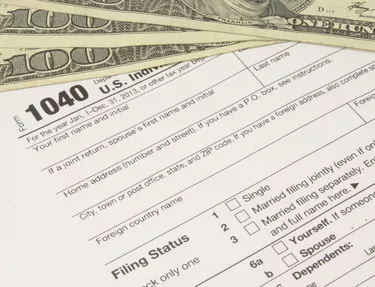
You can file your taxes and pay any amount you have due using the IRS E-file option, or send in your tax forms and payment using a delivery service like DHL, FedEx or UPS, or mail federal tax returns through the U.S. Postal Service. If you're going to use the latter route, make sure you prepare your documents correctly before you put them in your envelope, then decide how you want to send your package to make sure it arrives on time. Reviewing how to file taxes by mail will help you avoid a rejected or late submission.
Video of the Day
Video of the Day
Your Submission Options
You can submit your tax returns using the U.S. Postal Service, an IRS-approved private carrier or using e-file. If you use e-file, you can get your refund (if you have one) deposited directly to your bank account, which will be quicker than if the IRS has to process a paper tax return and mail you your refund check.
In addition, once the IRS has your bank account information, it can send you other monies more quickly, as well. For example, when the U.S. government sent COVID-19-related stimulus checks based on legislation passed during the Trump and Biden administrations, Americans who had E-filed and paid taxes or received refunds online received their stimulus payments in a matter of days, as opposed to other Americans who had to wait weeks to get their money through the U.S. mail.
Read More: How to Attach W-2s to Tax Returns
Preparing Your Submission
In order to help the IRS process your tax returns as quickly as possible (and get your refund as soon as possible), make sure you not only know how to mail taxes, but also how to file all of your paperwork correctly. In addition to filling out the correct forms, make sure to attach all related documents, such as a W-2 or 1099, correctly. Don't staple items to your 1040 or other tax forms – use a paper clip to make it easier for IRS employees to quickly process your return.
You should receive three W-2 forms from your employer, for example. One is for your personal records, one is for your state, and one is for the federal government. While the IRS will accept any one of those three, try to attach the one marked for the federal government. Attach it to the front page of your tax return.
Visit the IRS website to review the document, "How to Prepare Your Tax Return for Mailing" for more instructions on how to mail your tax return. Make sure you sign and date all documents where indicated and include your daytime phone number and Social Security number (including on any check you include). You might want to photocopy or take pictures of all of the documents you send (including the check) for your records.
Read More: What Happens if You Don't File Taxes?
Mailing Your Tax Documents
Place all of your documents into a stack you can easily slide into your envelope. You can place a stamp on the envelope and put it in your personal mailbox – your letter carrier will pick it up and return it to your local postal department. Use the address on the tax documents to mail your letter, or visit the IRS website for the correct address, based on where you live.
To avoid having to pay fines and penalties for non-filing or late delivery, your best bet is to take your letter or packet to your local post office and send it certified or registered mail. This will provide proof that you mailed something to the IRS, with the date you mailed it. You'll be able to track both types of letters online.
Certified mail requires the recipient (the IRS) to sign for the letter. You'll get confirmation that the letter was received and signed for. Sending your letter from the USPS will also guarantee that the letter will be postmarked the day you submit it, and you will make sure that you have the correct amount of postage on your letter or packet and avoid having it returned – possibly missing the April 15 deadline.